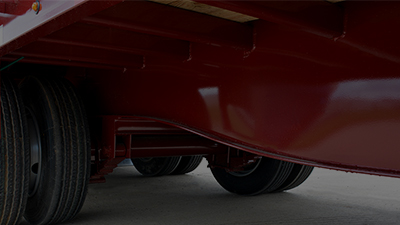Loading Options
GVWR vs Payload
Published November 7, 2024

What is GVWR?
So what’s the deal with words like GVWR, payload capacity, and curb weight? You’ll hear us refer to these a lot when talking shop about trailers, and it’s crucial to understand the differences and meanings behind these terms and how they relate to you and your trailer.
Simply put, your Gross Vehicle Weight Rating (GVWR) is the maximum amount of weight that your trailer is rated to carry. This number INCLUDES the weight of the trailer itself and the cargo/equipment you plan to haul. But this number in itself can be misleading, if you buy a 30K GVWR trailer it does not mean you can haul 30,000 lb of equipment on it – that’s where knowledge of your trailer’s payload capacity comes in. This is the true amount of weight your trailer is safely rated to haul.
How do I find out my trailer’s payload capacity?
To calculate payload capacity use this simple formula:
GVWR – Weight of Trailer = Total Payload Capacity
The weight of the empty trailer is often referred to as “curb weight”. Remember to include any accessories, like toolboxes, chain trays, or spare tires in this weight.
In real-life numbers, if you purchase one of our Fleetneck FMAX312 gooseneck trailers with a GVWR of 30,000 lbs and a curb weight of 9,000 lbs (approximate), to determine your maximum allowed payload capacity you would calculate:
30,000 (rated GVWR) – 9,000 (curb weight) = 21,000 lb (payload capacity)
It is very important to know your trailer’s GVWR and curb weight BEFORE hauling extreme loads to ensure you do not damage your trailer by overloading it. (If you are unsure about your trailer’s approximate curb weight, please contact your nearest Diamond C DEALER or take your trailer to a weigh station for a more accurate weight).
GVWR Videos
Listen in as Jacob Crabb explains GVWR further in these short videos, along with some practical tips for choosing the best-rated trailer for your required haul.
Trailer Weight Distribution
Even if you are loading less than the maximum payload, it’s still important to use common sense when loading and observe some best practices for even load distribution:
- Distribute your cargo as evenly as possible between the entire length of the trailer.
- As a general rule of thumb, 60% of the weight of the cargo/equipment should be nearer the front of the trailer than the rear. Load heavier equipment nearer the tongue/neck of the trailer, and place lighter equipment closer to the rear.
- Avoid uneven left/right loads as well – these can not only cause abnormal tire wear, wheel, or even axle damage, but also result in dangerous swaying while driving.
- On DC trailers with our industry exclusive 12’ HYDRAULIC DOVETAIL, make sure to distribute weight as evenly as possible across the length of the tail. Our hydraulic dovetail is rated to lift and carry up to 10,000 lb evenly distributed, but an undistributed load (too much weight rearward) can cause premature wear and unnecessary damage to the tail.
Loading Tips Video
Watch below as Randal demonstrates some best practice loading tips for even weight distribution, along with some examples of what to avoid.
Lighter Weight – Stronger Frame
At Diamond C, we want your investment to work as hard as you. That’s why we are so passionate about the significant impacts our ENGINEERED BEAM TECHNOLOGY can have for trailer owners, as it allows our trailers (especially higher GVWR and longer GOOSENECKS) to have lighter, but stronger frames. A lighter frame results in a lower curb weight, which means a higher payload capacity for you to haul. For example, our FMAX216 gooseneck trailer in a base 40′ configuration has an average curb weight of 1,100 lbs LESS than the competition. When tackling the most grueling jobs around, that extra payload capacity available plays a big part, especially for HOT SHOT trailer users! #DoWork

Build Your Own Trailer
Click below to view the GVWR and price of every Diamond C trailer model and customize your own model.
BUILD & PRICE

